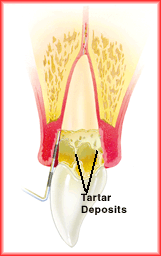Periodontal diseases are infections of the gums that gradually destroy the support of your natural teeth. Dental plaque is the primary cause of gum disease in genetically-susceptible individuals. Bacteria found in plaque produce toxins or poisons that irritate the gums. They may cause them to turn red, swell, and bleed easily. If this irritation is prolonged, the gums separate from the teeth causing pockets (spaces) to form. Plaque can also harden into a rough, porous substance known as calculus (or tartar). This can occur both above and below the gum line.
As periodontal diseases progress, the supporting gum tissue and bone that holds teeth in place deteriorate. If left untreated, this leads to tooth loss.
However, don’t be fooled. With periodontal disease, bleeding, redness, and swelling do not have to be present. Further, pain is usually not associated with periodontal disease. This disease damages the teeth, gum, and jawbone of more than 80 percent of Americans by age 45.
Scaling and root planing is a careful cleaning of the root surfaces to remove plaque and calculus [tartar] from deep periodontal pockets and to smooth the tooth root to remove bacterial toxins. Scaling and root planing is sometimes followed by adjunctive therapy such as local delivery antimicrobials, systemic antibiotics, and host modulation, as needed on a case-by-case basis.
Most periodontists would agree that after scaling and root planing, many patients do not require any further active treatment. However, the majority of patients will require ongoing maintenance therapy to sustain health.
our bone and gum tissue should fit snugly around your teeth like a turtleneck around your neck. When you have periodontal disease, this supporting tissue and bone is destroyed, forming "pockets" around the teeth.
Over time, these pockets become deeper, providing a larger space for bacteria to live. As bacteria develop around the teeth, they can accumulate and advance under the gum tissue. These deep pockets collect even more bacteria, resulting in further bone and tissue loss. Eventually, if too much bone is lost, the teeth will need to be extracted.

Mild Periodontitis

Advanced Periodontitis
Your periodontist has measured the depth of your pocket(s). A periodontal pocket reduction procedure has been recommended because you have pockets that are too deep to clean with daily at-home oral hygiene and a professional care routine.
During this procedure, your periodontist folds back the gum tissue and removes the disease-causing bacteria before securing the tissue into place. In some cases, irregular surfaces of the damaged bone are smoothed to limit areas where disease-causing bacteria can hide. This allows the gum tissue to better reattach to healthy bone.
Reducing pocket depth and eliminating existing bacteria are important to prevent damage caused by the progression of periodontal disease and to help you maintain a healthy smile. Eliminating bacteria alone may not be sufficient to prevent disease recurrence. Deeper pockets are more difficult for you and your dental care professional to clean, so it's important for you to reduce them. Reduced pockets and a combination of daily oral hygiene and professional maintenance care increase your chances of keeping your natural teeth – and decrease the chance of serious health problems associated with periodontal disease.
